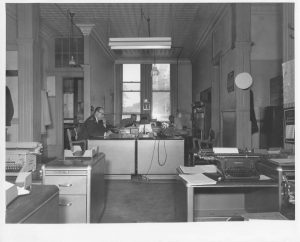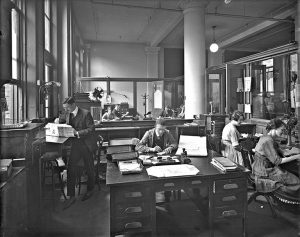10 The American Narrative
The Declaration of Principles 1905
In 1905 Ivy Lee and his partner George Parker were publicists, advising coal operators on how to respond to an ongoing anthracite coal strike. Lee issued the declaration to counter complaints from journalists about their inability to gain access to information, accusations of propaganda disguised as news stories, and other strategies by corporate owners to manipulate the information presented in the media (Olasky, 1987). The document itself was a one-page statement, distributed to American reporters and editors of the time.
 According to Morse (1906), at the time of the 1905 strike Lee sent to city editors the following “declaration of principles”:
According to Morse (1906), at the time of the 1905 strike Lee sent to city editors the following “declaration of principles”:
This is not a secret press bureau. All our work is done in the open. We aim to supply news. This is not an advertising agency; if you think any of our matter ought properly to go to your business office, do not use it. Our matter is accurate. Further details on any subject treated will be supplied promptly, and any editor will be assisted most cheerfully in verifying directly any statement of fact. Upon inquiry, full information will be given to any editor concerning those on whose behalf an article is sent out. In brief, our plan is, frankly and openly, on behalf of business concerns and public institutions, to supply to the press and public of the United States prompt and accurate information concerning subjects which it is of value and interest to the public to know about. Corporations and public institutions give out much information in which the news point is lost to view. Nevertheless, it is quite as important to the public to have this news as it is to the establishments themselves to give it currency. I send out only matter every detail of which I am willing to assist any editor in verifying for himself. I am always at your service for the purpose of enabling you to obtain more complete information concerning any of the subjects brought forward in my copy. (Morse, 1906, as cited in Miller Russell & Bishop, 2009, p. 460)
Previous scholarship has identified the writing and dissemination of this Declaration of Principles as “a seminal moment in public relations history” (Miller Russell & Bishop, 2009, p. 93). This document is held up in the dominant narrative of public relations history as the defining moment where publicity was claimed as a legitimate form of communication (Hallahan, 2002). Equally important, the Declaration was welcomed and accepted by journalists. Editors welcomed the opportunity to work with Lee and publicity was again seen as a useful communication role.
However, Lee’s legacy is not without criticism. Olasky (1987) asserts that although Lee’s declaration was factually accurate, it implied a level of truthfulness or a willingness to “put all his cards on the table” which was not the case. Lee’s work was accurate but slanted to convey clear perspectives to the audience. At that time, largely about the issue of corporate trusts which dominated the American political economy at the time. This propensity towards unethical practice came up again in Lee’s career as he was criticized for unethical practice while working for the Rockefeller family during another coal strike in 1914 in Colorado. Even later on in his career, Lee is criticized for working with clients of questionable integrity (Olasky, 1987).
Lee’s personal legacy aside, his Declaration of Principles has been incorporated into the dominant narrative of public relations ethics in an, for the most part, ahistorical manner. The Declaration itself represents a point in time in the narrative as the moment when public relations moved away from shady misinformation and towards a more enlightened call for ethical communication. When this ‘moment’ is put into context it offers a very different narrative. The history in this context is framed within the changing economic landscape in the United States, the friction between journalists and public relations practitioners around corporate trusts, and the growing competition between journalists and public relations practitioners to inform the public, it offers a very different narrative.
Propaganda 1928
Following in Lee’s tradition of defending the standards of public relations practice, another key figure, Edward Bernays, emerged on the scene several years later. A strong advocate for high standards in public relations practice, Bernays called for licensing and professionalization in public relations throughout his career (Bernays, 1984). Depending upon the traces used to re-assemble histories of public relations ethics, the motivation for increased focus on ethics standards has been attributed to improved professional education, theoretical evolution of the discipline to a more enlightened two-way model of communication, and the shear growth in numbers within the field following the Second World War. Although scholars may debate the relative merit of these different perspectives, “there is one key motivator in the call for ethical practice which is consistently put forward; ethical standards are a requirement of professionalization” (Edgett, 2002, p. 3). Bernays’ commitment to the need for professionalization ran parallel to the move towards professionalization in journalism. In the 1920s, both PR and journalism struggled to define roles, identity and ethical standards. During the 1920s the tension between journalists and public relations practitioners that Ivy Lee had attempted to diffuse was heating up once again. At the end of the First World War, the field of journalism was stinging from the way that reporters had been successfully enrolled in the dissemination of wartime propaganda by the government.
In the early 1920s work on professionalization within journalism began in earnest, starting with a distancing of that field from public relations. PR practitioners were painted in a very negative light as propagandists. Journalism took on an approach of scientific method, where “truth” was gathered from experts and reported objectively to the public. The first code of ethics for the American Society of Professional Journalists was adopted in 1926 (Society of Professional Journalists, 2014), calling for, among other things, “sincerity, truthfulness and accuracy in reporting” (Vaughn, 2007, p. 159).
 In 1923, Bernays wrote Crystalizing Public Opinion. This book was an important first attempt to define the value of public relations in the role of advocacy or as an avenue for the publicity for minority voices. Bernays “articulated that propaganda presented its own vital truth claims – those who had new minority ideas could use propaganda to surface their contentions through the media and push an indolent majority toward progress” (St John, 2009, p. 354).
In 1923, Bernays wrote Crystalizing Public Opinion. This book was an important first attempt to define the value of public relations in the role of advocacy or as an avenue for the publicity for minority voices. Bernays “articulated that propaganda presented its own vital truth claims – those who had new minority ideas could use propaganda to surface their contentions through the media and push an indolent majority toward progress” (St John, 2009, p. 354).
Bernays followed up on this point in his subsequent book, Propaganda, published in 1928. In Propaganda, Bernays discusses the origins of the field of public relations along with the rights and responsibilities of practitioners. His statement of responsibilities focused for the most part on issues of conflict of interest, and the need to openly identify the client or source of the information being presented. Many of the statements put forward by Bernays in this book are mirrored in the current code of ethics of the Public Relations Society of America.
In publishing Propaganda, Bernays took on the media establishment by attempting to demonstrate that “propaganda promoted the knowledge and agendas of the minority voice, from civil rights to new fashion trends, resulted in press attacks on propaganda as corrosive to journalism” (St John, 2009, p. 354). The New York Evening Post printed one of the first reviews of Propaganda on November 15, 1928, under the headline ‘‘Boobery in the Making Revealed at Last.’’ Bernays, said the un-bylined piece, treats the public like it is a boob that needs to have its collective head crammed with ideas; the public relations counsel is ‘‘the magician who makes ideas dance inside our thick domes’’ (St John, 2009, p. 361).
Other papers printed similar reactions, most criticizing Propaganda for characterizing public relations as unconcerned with truth and accuracy and attempting to convince the public of events or issues that may or may not be true. Although Bernays continued for decades after Propaganda to have a successful public relations career, he ultimately lost the battle to re-define propaganda. The press successfully constructed the term in a pejorative manner, and public relations attempted to disassociate itself from the label.
 In the dominant narrative of public relations ethics, propaganda is essentially dismissed as an unfortunate stage in the early years of the profession prior to the evolution of more enlightened and ethical practice. This narrative limits the discussion on propaganda from a perspective of public relations ethics and, in part, contributes to a limiting of the possibilities of theorizing from other perspectives within the profession. The ahistorical approach to theorizing in public relations has “caused and resulted in historical distortions … and ethical oversimplifications like the dissociation of public relations from propaganda.” (Brown, 2006, p. 206).
In the dominant narrative of public relations ethics, propaganda is essentially dismissed as an unfortunate stage in the early years of the profession prior to the evolution of more enlightened and ethical practice. This narrative limits the discussion on propaganda from a perspective of public relations ethics and, in part, contributes to a limiting of the possibilities of theorizing from other perspectives within the profession. The ahistorical approach to theorizing in public relations has “caused and resulted in historical distortions … and ethical oversimplifications like the dissociation of public relations from propaganda.” (Brown, 2006, p. 206).
Throughout his career, Bernays was himself the strongest advocate for professionalization in America, and he played an important role in the development of the first PRSA code of ethics in 1952. Perhaps ironically, more recent research has presented Bernays as a practitioner with questionable ethics as he has been criticized for unethical behavior on behalf on several high profile clients over the years (Bivens, 2013).
The PRSA Code of Ethics 1950
Although some public relations scholars have criticized codes of ethics as simply “window dressing” (Hunt & Tirpok, 1993) and not reflective of the state of ethics in the profession, the codes themselves do represent important texts which construct existing narratives of public relations practice. As the established record of stated ethical standards for the professional associations of public relations practitioners in both Canada and the United States, these documents, and the contexts in which they were produced, provide insight into the evolution of public relations ethics in these two countries.
On December 4, 1950 the Public Relations Society of America (PRSA) introduced one of the first codes of public relations ethical standards. The code was described at the time “as a compromise between those who were striving for ideal if not idealistic behavior and those who wanted no Code at all” (Calver, 1951, p. 53). As one of the founders of the original code stated: “the fact that public relations has a Code of Ethics is certainly unknown to most users of public relations and will be surprising to many” (Calver, 1951, p. 53; OECD, 2012). Although general in content and vague in practical guidance, the brief document laid the groundwork for future codes and established the direction of its successors. It emphasized serving the public interest; avoiding conflicts of interest; communicating honestly; avoiding misrepresentations to clients, employers, and others; and the continuing professional development of public relations practitioners (Fitzpatrick, 2002, p. 90).
This first, general code of ethics was revised in 1959 to a broader code which was expanded to include two paragraphs directly related to enforcement. The new provisions required members to serve if called as a witness in an enforcement proceeding and to “co-operate with fellow members in upholding and enforcing this Code” (PRSA, 1959). Perhaps because ethical account ability had become increasingly important to Society leaders, the drafters of the 1959 code placed more weight on “improper” (Watson, 1960, p. 23) activities than on ethical best practices, relying heavily on the phrase “shall not” (Fitzpatrick, 2002, p. 93).
This move towards enforcement is interesting, but perhaps not surprising, as the image of public relations practitioners in society, and in the press was quite negative by this time. Enforcement remained a primary concern of the PRSA code for decades until in the revision of 2000 the Society acknowledge that enforcement has not worked. At that point, the focus returned to that of individual accountability and responsibility.
References
Bivens, T. H. (2013). A Golden Opportunity? Edward Bernays and the Dilemma of Ethics. American Journalism, 30(4), 496-519.
Brown, R. E. (2006). Myth of symmetry: Public relations as cultural styles. Public Relations Review, 32(3), 206-212.
Calver, H. (1951). Now that we have a Code. Public Relations Journal, 3-17.
Edgett, R. (2002). Toward an ethical framework for advocacy in Public Relations. Journal of Public Relations Research, 14(1), 1-26.
Fitzpatrick, K. (2002). Evolving standards in Public Relations: A historical examination of PRSA’s Code of Ethics. Journal of Mass Media Ethics, 17(2), 89-110.
Hallahan, K. (2002). Ivy Lee and the Rockefellers’ response to the 1913-1914 Colorado Coal Strike. Journal of Public Relations Research, 14(4), 265-315.
Hunt, T. & Tirpok, A. (1993). Universal ethics code: An idea whose time has come. Public Relations Review, 19(1), 1-11.
Miller Russell, K., & Bishop, C. (2009). Understanding Ivy Lee’s declaration of principles: W.S. newspaper and magazine coverage of publicity and press agentry, 1865-1904. Public Relations Review, 35(2), 91-101.
Morse, S. (1906). An awakening in Wall Street. The American Magazine, 457-463.
OECD. (2012). Lobbyists, Governments and Public Trust, Volume 2: Promoting Integrity through Self-regulation. OECD Publishing.
Olasky, M. N. (1987). Ivy Lee: Minimizing Competition through public relations. Public Relations Quarterly, 32(3), 9.
Public Relations Society of America. (2021). PRSA Member Code of Ethics. Retrieved from www.prsa.org/aboutprsa/ethics/codeenglish
Society of Professional Journalists. (2021). SPJ Ethics. Retrieved from http://www.spj.org/ethicsfaq.asp#2.pdf
St John, B. (2009). Claiming Journalistic Truth: US press guardedness toward Edward L. Bernays’ conception of the minority voice and the “corroding acid” of propaganda. Journalism Studies, 10(3), 353-367.
Vaughn, S. L. (2007). Encyclopedia of American Journalism. London: Routledge.
Watson, B. (1960, October). Whither the Society’s code? Urgently needed—understanding of the new code and its enforcement. Public Relations Journal, 23–26.
Communication messages used to influence a public; not necessarily factual

